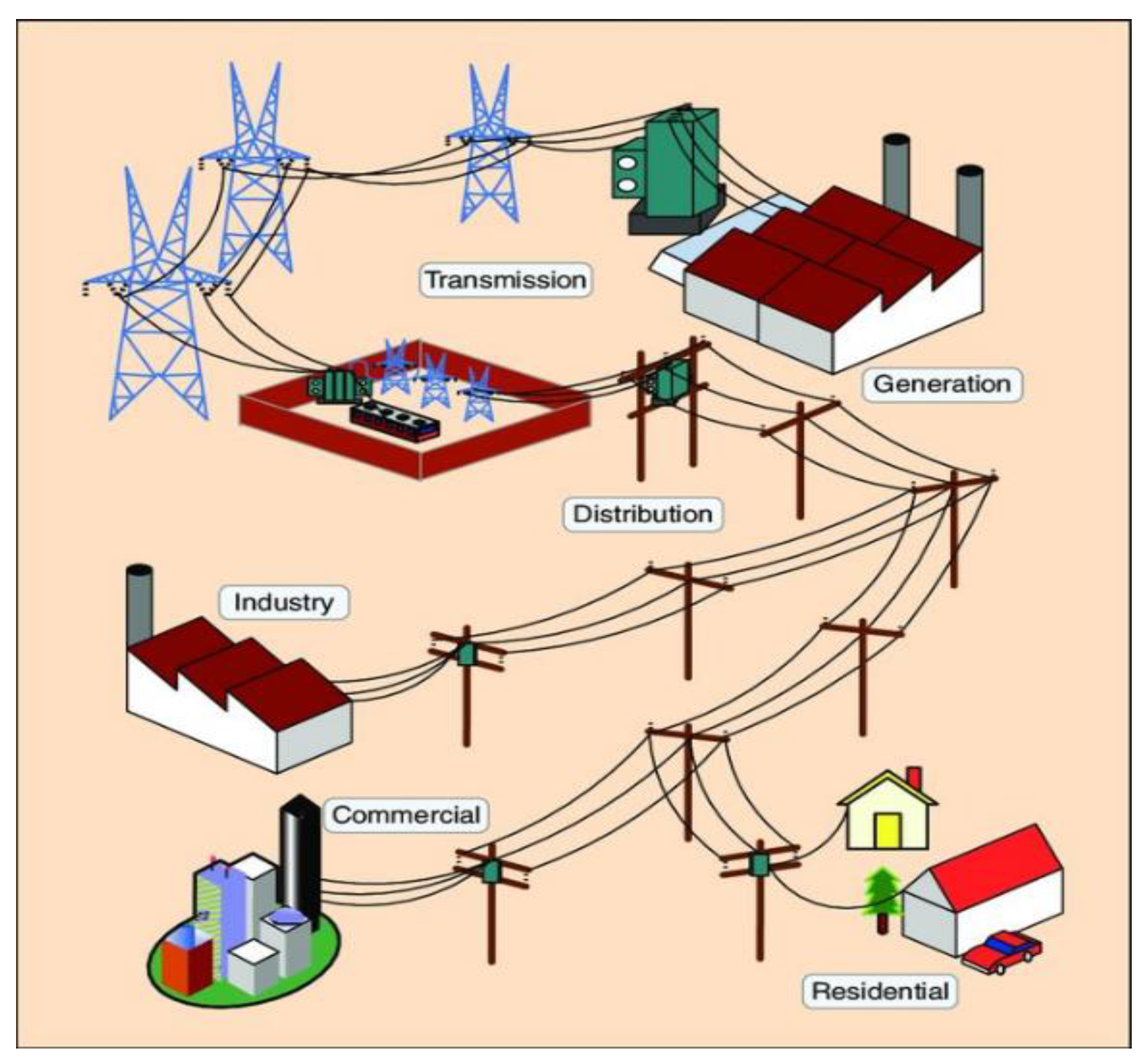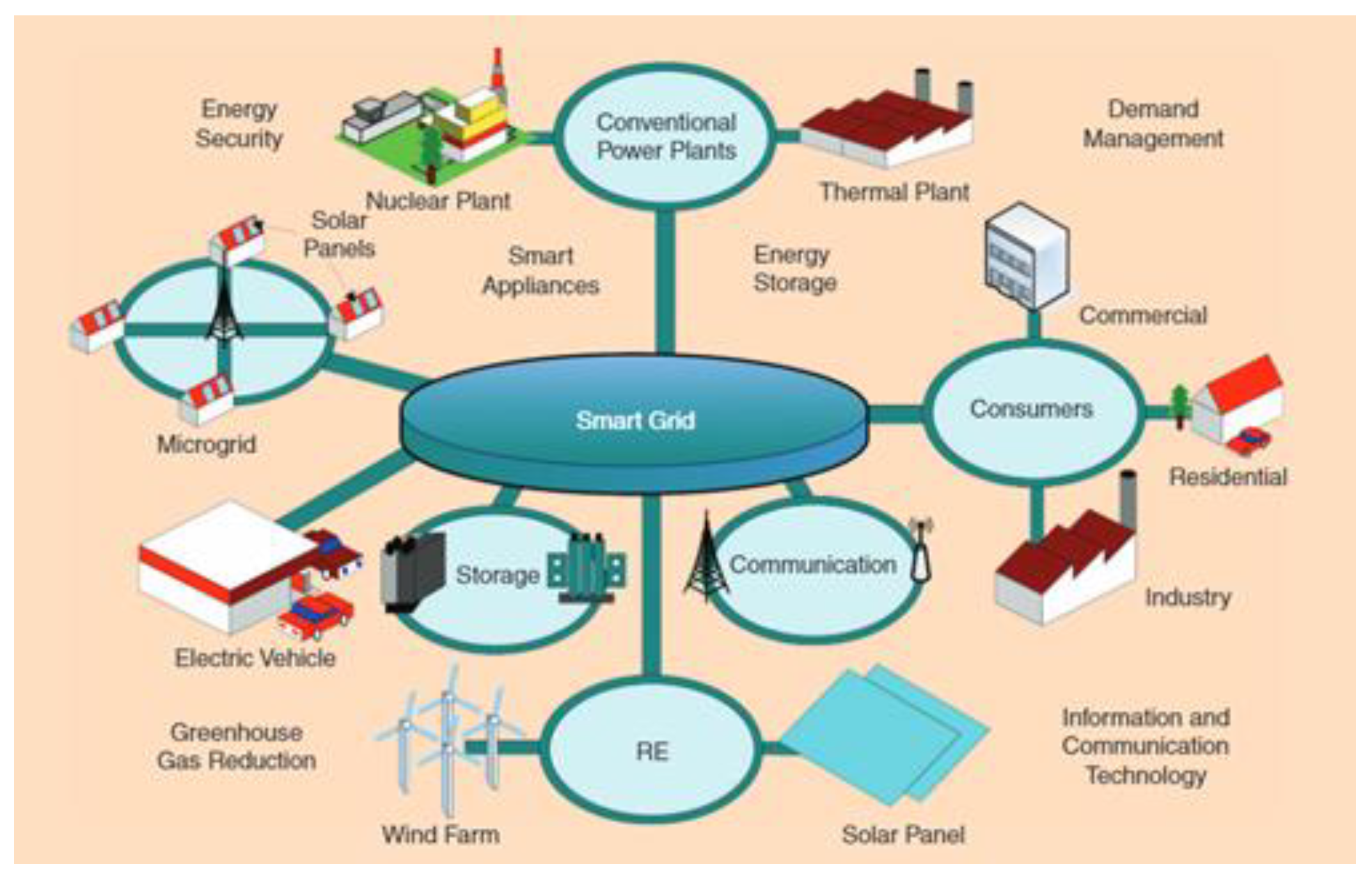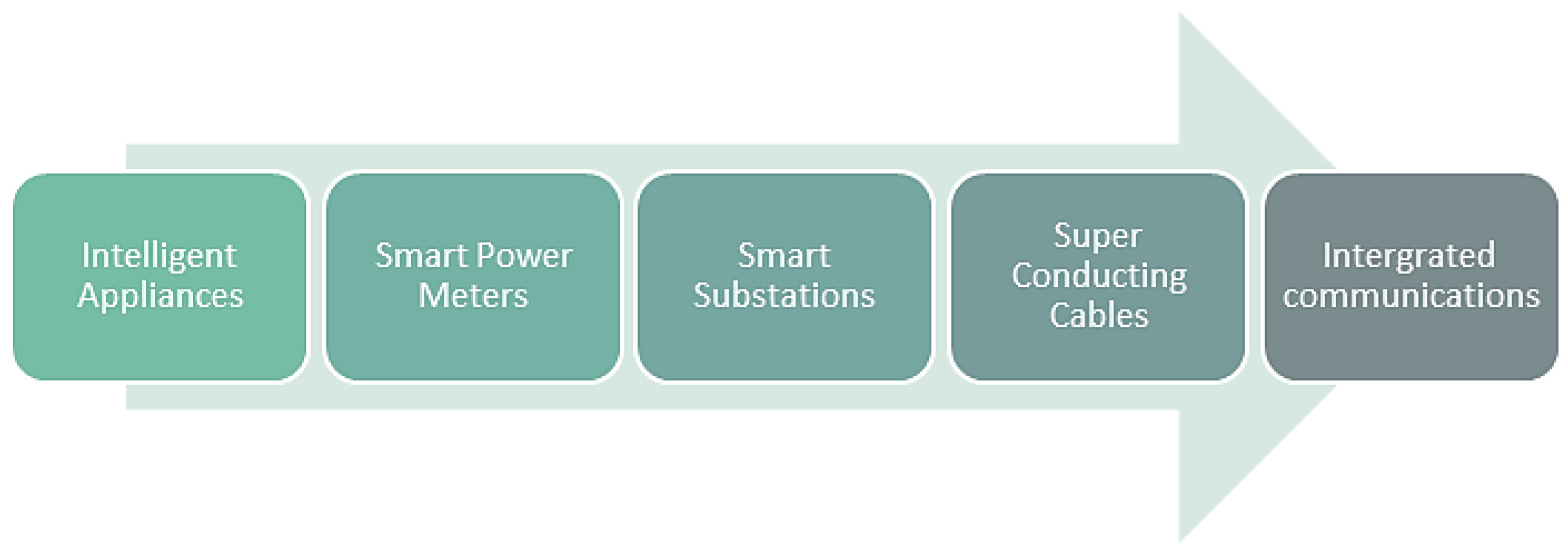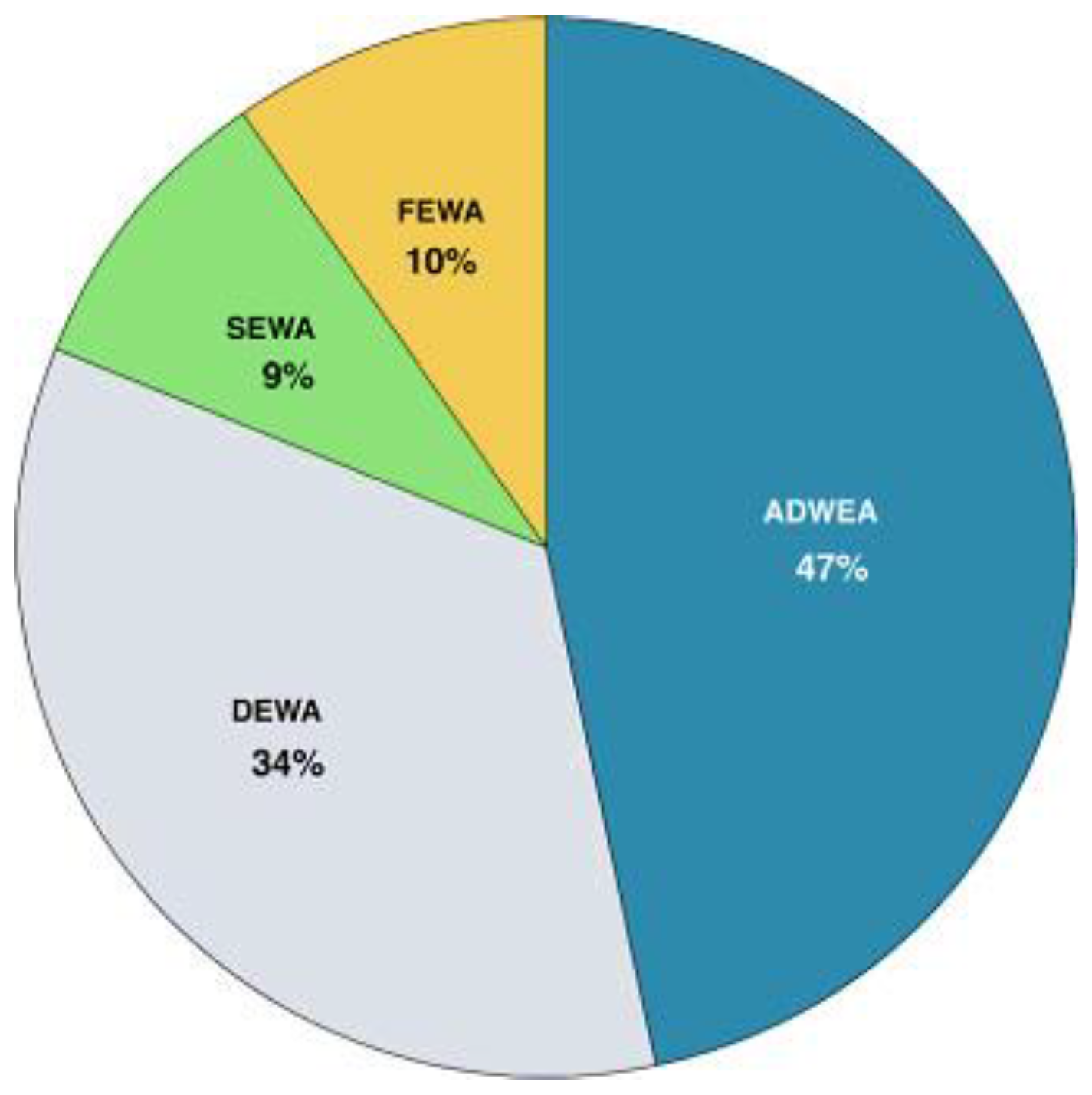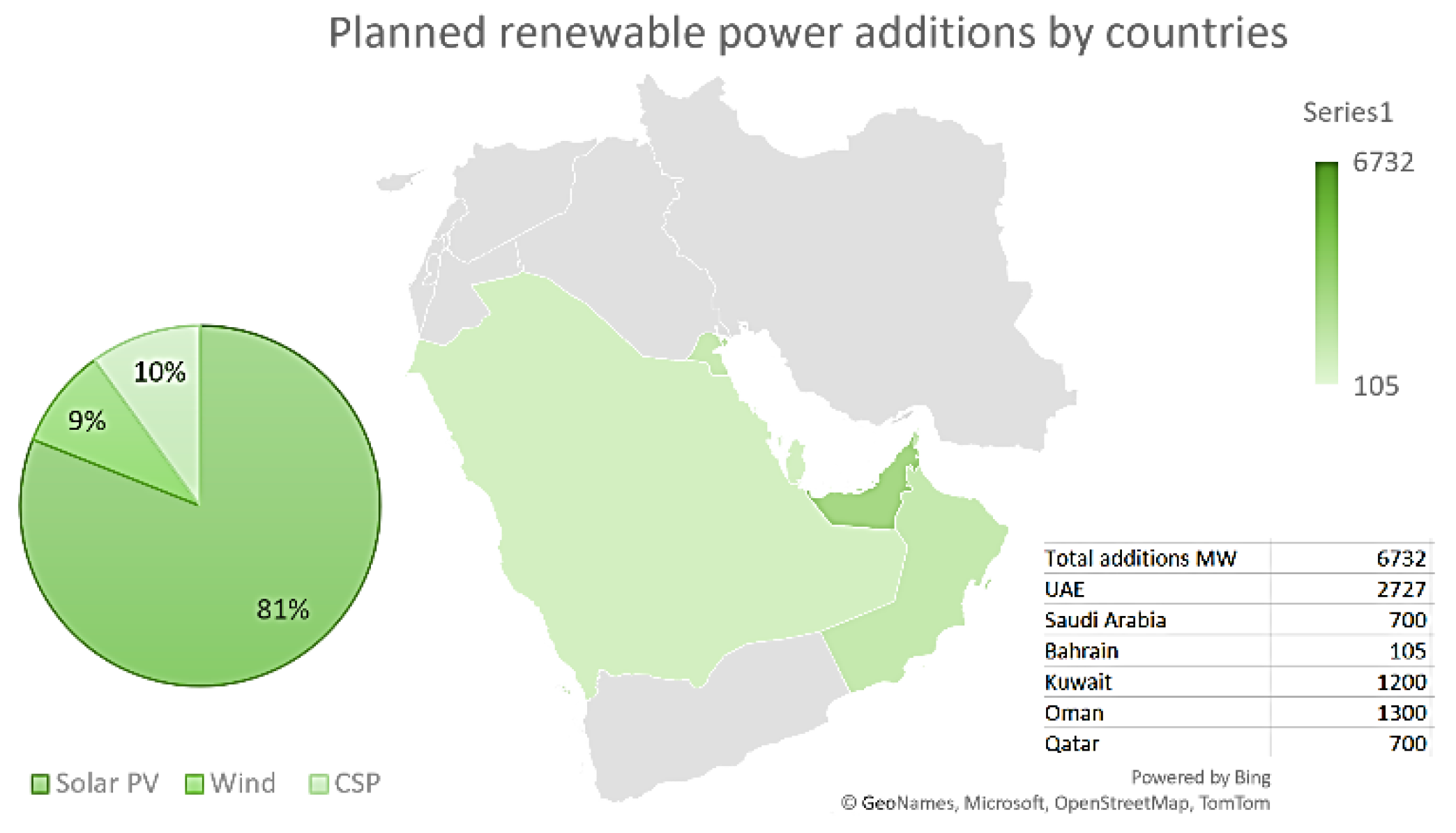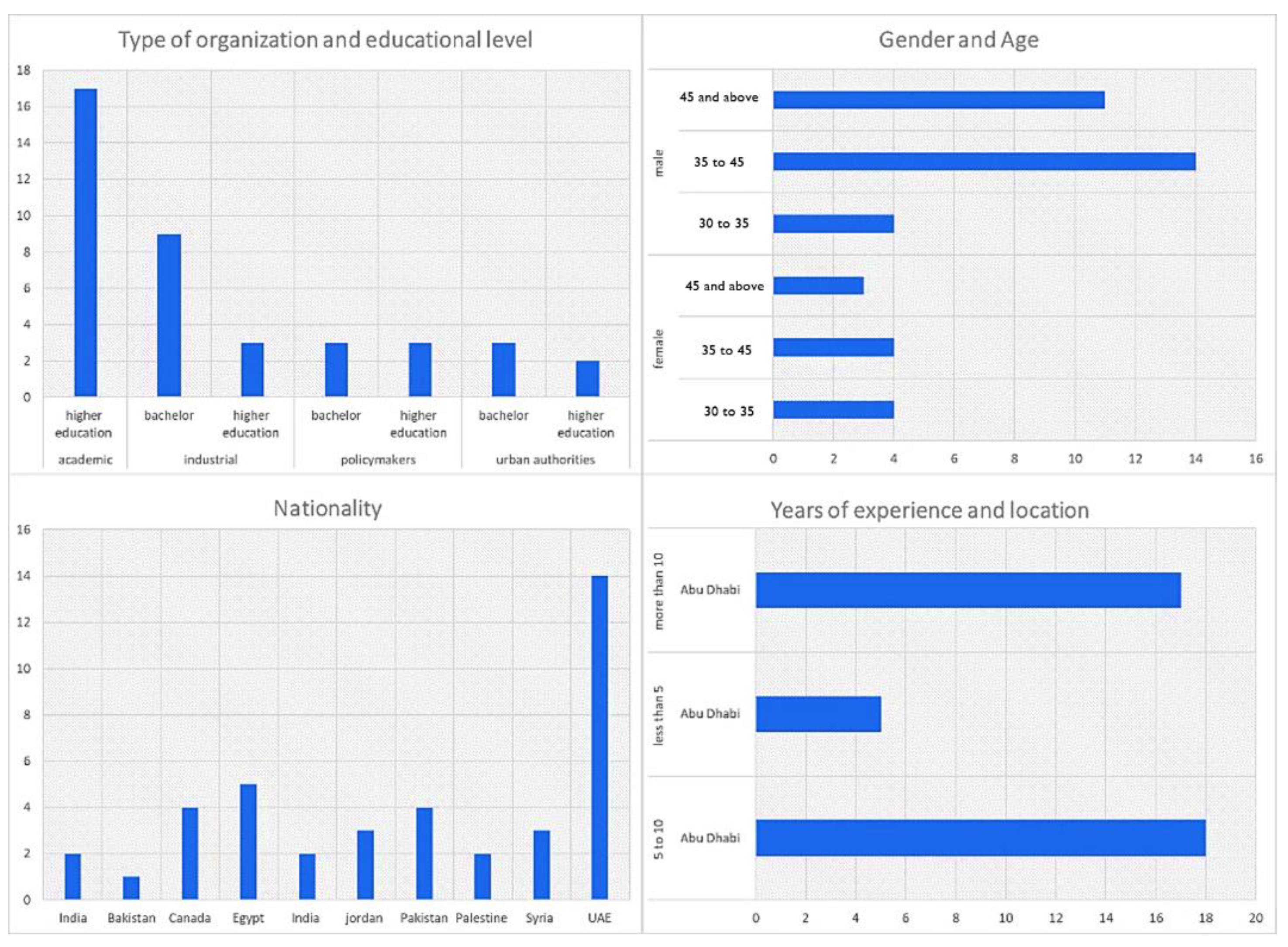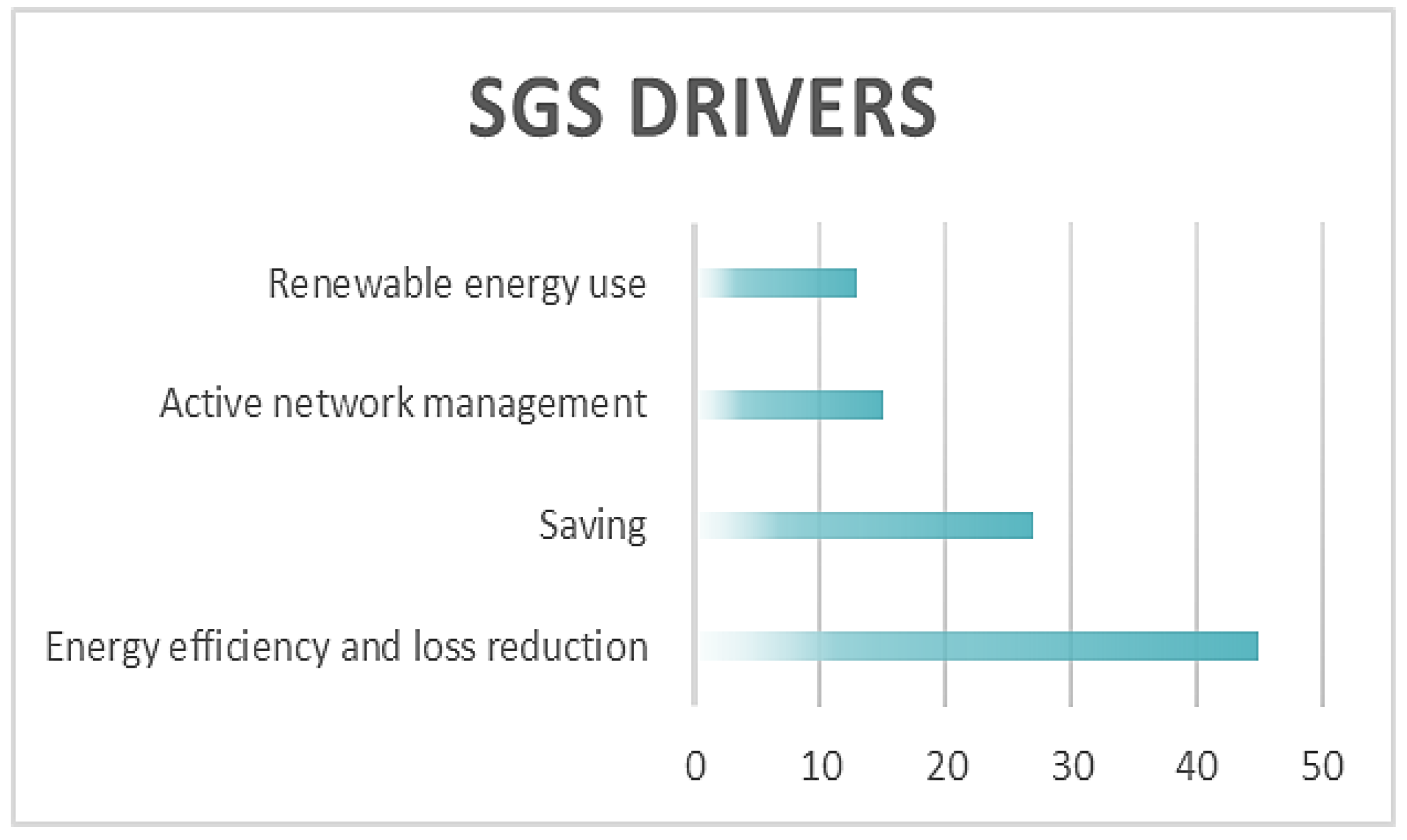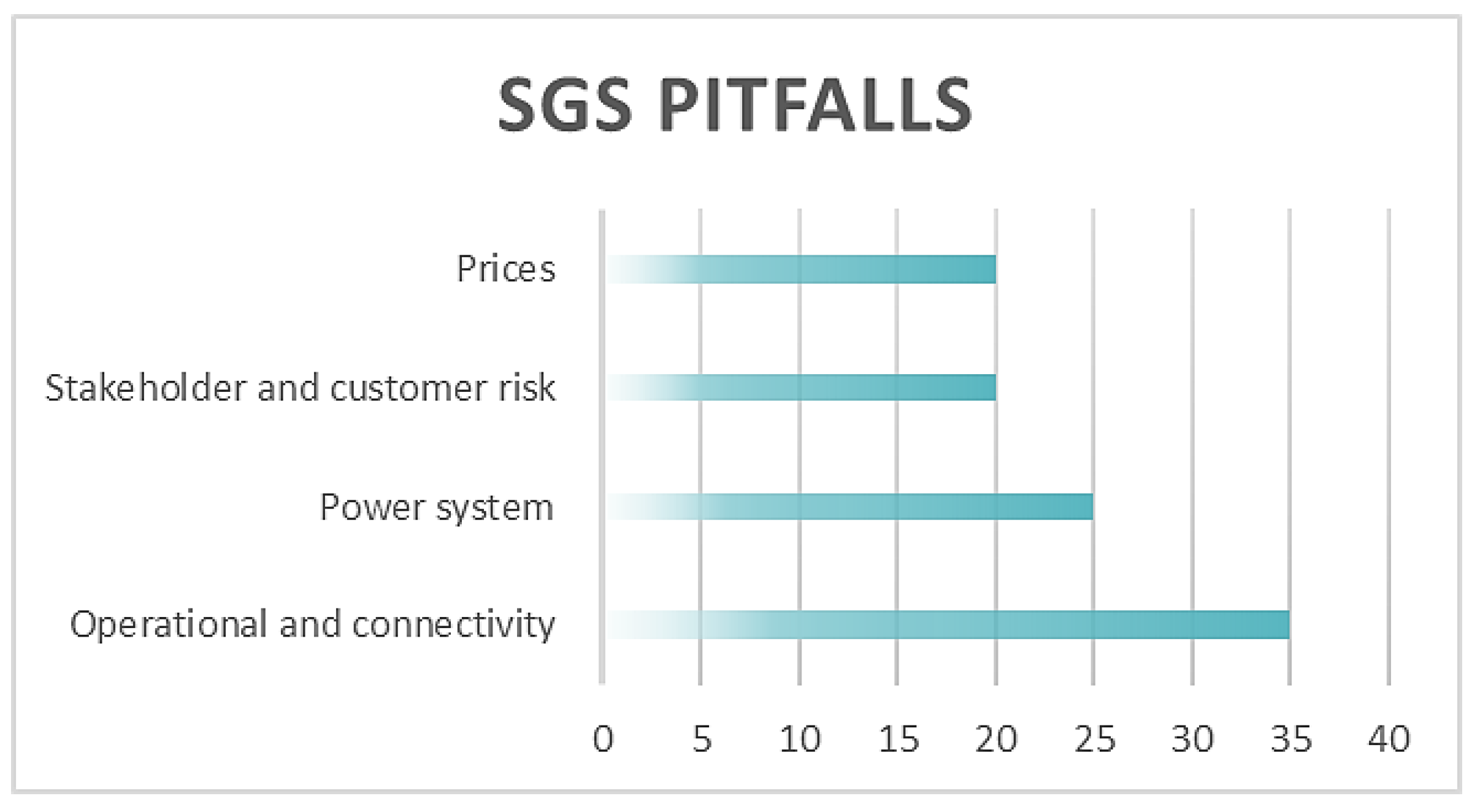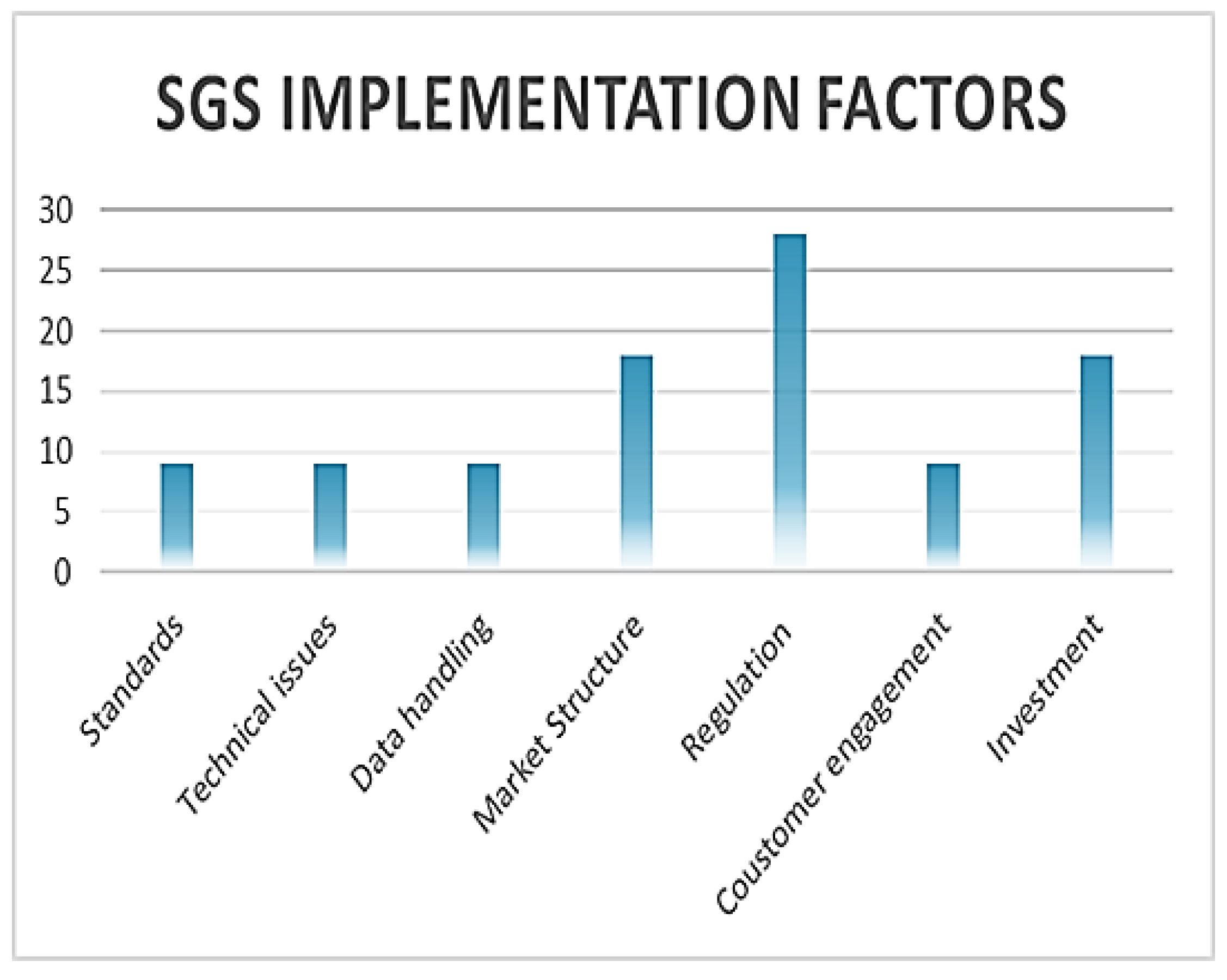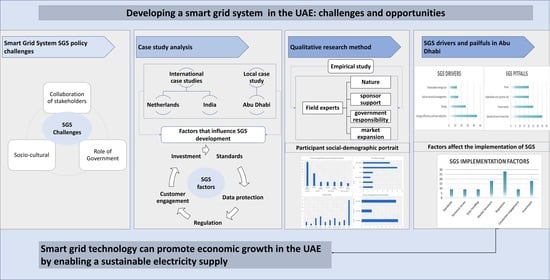1. Introduction
The massive reduction in energy availability has become a major concern for using energy resources and many eco-friendly issues, such as poisonous fumes and weather changes. According to the Clean Energy Progress Report released by the IEA in 2011, global energy consumption is predicted to double by 2025 [
1]. Building capabilities should be created using the least amount of energy possible to avoid such troubles. Therefore, energy efficiency and preservation systems must be adopted. The utilization of energy has many statistical measures that can be used to gauge changes in energy consumption. In the same way, reducing power consumption involves lowering energy consumption in comparison to its current level [
2].
Recently, Gulf Cooperation Council (GCC) countries have realized they could end up with energy insecurity due to overreliance on oil. Thus, several GCC countries have established renewable energy targets by 2030–2040 and committed substantial investments toward that goal [
3,
4]. In order to generate, store, and distribute energy in this new direction, innovative techniques will be needed in the infrastructure. A promising long-term industry transformation solution is the next-generation electric power system called “smart grids” [
5]. A two-way flow of both electrical power and information is expected to revolutionize the generation, storage, transmission, and distribution of electricity under the SGS [
6]. Additionally, this new system will include environmental alternatives, such as wind, solar, and biomass.
The research hypothesis was based on the fact that most electricity distribution systems in the world were built at a time when energy prices were relatively low, as well as the fact that some minor upgrades have been made to the primitive grid network over time. It is imperative to use modern technology to keep up with the growing demand for energy, and since renewable energy is becoming more prevalent, an improved grid is needed to accommodate its components. Smart grid technologies are becoming increasingly popular today as a result of the numerous technological applications that come from industry players, researchers, and investors [
7]. However, these technological applications are infrequently implemented in the UAE region. In addition to contributing to the sustainable development goals SDG objectives through its effective operations in minimizing costs and reducing environmental pollution, this work could be considered an initial step towards the realization of the smart grid infrastructure in the region [
8]. The main objective of this study is to evaluate the challenges of developing a smart grid system in Abu Dhabi by conducting a specific survey aimed at extracting and analyzing the most significant guidelines and issues that affect the progress of the implementation of a smart grid system for the city.
In the first section, this paper outlines a literature review including information about the UAE’s energy consumption and smart grid technology, followed by a discussion of three major challenges associated with smart grid policy, namely socio-culture, stakeholders’ involvement, and government association. In the second part of the study, the lessons learned will be summarized through an analysis of international case studies and a local case study in the UAE, Abu Dhabi, which will highlight the key issues and challenges, and then the Delphi method will be used to summarize the results of the empirical study. Finally, the final conclusion and recommendations are presented based on the results of the survey and describe the main factors influencing the development of the SGS.
2. Literature Review
2.1. Traditional Grid Networks
A typical grid network system is shown in
Figure 1. In a traditional power system, the distribution system is fairly extensive due to limited communication and limited local control. It basically acts as a load energy supplier based on demand. In general, the thermodynamic cycles, such as those in fossil fuel power plants, have limited efficiency of around 30% or less, and several other losses including transmission and distribution casualties [
9]. A traditional electric power grid consists of high-voltage transmission lines that transport the generated electricity to distribution networks for a consumption “one-way network”. It is important to understand that each stage—generation, transmission, and distribution—has its own engineering challenges. As a result of interdependence between the power grid elements, cascade effects may result; for example, a big blackout, when several small events happen at roughly the same time and result in the entire system collapsing [
10]. Thus, smart grids were developed.
2.2. Smart Grid System
A random action was initially involved in the supply of clean energy. To overcome this problem, smart grids have been developed to increase the amount of energy produced. In a smart electrical network or smart grid, conventional electrical systems are combined with state-of-the-art technology in order to create and distribute electricity from multiple distributed sources [
11], including renewable energy sources such as windmills, solar panels, and wind turbines, as shown in
Figure 2. The smart grid incorporated a two-way communication process that allowed consumers to get their energy source as well as to contribute to the grid effectively [
12].
The use of smart grids for energy is justified by a number of factors. In the first place, non-RE sources are limited on Earth. The importance of renewable energy sources is growing for future energy supply. Furthermore, environmental pollution continues to rise; almost all energy production and use are associated with environmental defilement.
The smart grid’s main aim is to produce and move the energy between various nodes straightforwardly, as well as to increase energy production and simplify its distribution, and ensure consistency between energy production and consumption by consumers to achieve efficiency [
13]. A smart grid system (SGS) has many modules, each with a specific task to accomplish the process, as illustrated in
Figure 3. In the bright apparatus, the time of energy consumption can be set based on the information entered by the user, and the highest load energy and price can be managed by intelligent sensors. With smart power measures, you can collect bills and locate system problems in any location, thanks to two-way communication. Smart substations are responsible for managing and monitoring the power function and standing. Various voltages are converted at the stations to reach the consumers and to divide the energy stream in different ways. A key aspect of smart grid interaction is combined communication, which must be very fast in order to give outputs promptly. When it comes to smart grid interaction, there are some technologies to be applied based on need [
14].
2.2.1. Demand Side Management
The electrical distribution market requires precise control to ensure that the energy supply is not changed, but with the development of renewable energy, this may be changed due to the limited sources of energy creation [
15]. Demand-side management (DSM) investigated this matter to find out whether there were other options available for energy production. Through DSM, the main objective is to motivate clients to consume less energy, whether they are at home or not, resulting in a reduction in demand [
16].
Two main categories can be made for energy management activities: supply side management (SSM) and demand side management (DSM), which involve using effective devices to reduce power waste and decrease energy bills. According to several scientists who specialize in green power production, DSM is a technical control of electricity usage that should achieve less energy consumption [
17]. The focus of DSM is to provide energy with competitive prices to all consumers with free services and to prevent power outages [
18].
2.2.2. The Importance of the Smart Grid System
Many features that can help the market grow when the systems store and analyze data include searching for affordable, flexible energy sources and calculating the total cost of expansion; this will eventually compel consumers to use less energy and raise awareness [
19]. Energy management is a key point that can be achieved through smart grid plans. Many nations have improved their energy output through the development of smart grid policies that increase demand and supply in accordance with financial and political burdens, based on new technologies for power production and consumption. In contrast, there are three key points that affect the security of the operation of the smart grid, which are energy security, privacy policies, and maintenance policies [
20].
As part of the smart grid project, a large amount of data is generated via and from consumers and public facilities, which requires high-tech hardware and software that requires performance preservation and control from the date of its allocation to the end of its lifetime. One of the greatest challenges of smart grid projects is the security of the Internet. A digital attack on the smart grid network could affect homes, public facilities, and governing authorities. Many attacks have been performed, such as accessing the local energy consumption data, which is able to give some details on whether the places are occupied or how many people are at home. Guidelines should be set by the governments to ensure the security of the smart grid to assist in the safety issues, such as smart gauges with a strict social function that manages these networks and follows up on them [
21].
There are several factors that contribute to the need for smart grids in developed and developing countries. In order to address these factors, the IEA developed a technical roadmap for smart grid development for regions and developing countries; however, the latter face more challenges. The most important ones are:
2.3. Challenges of Smart Grid Policy
The smart grid employs the usage of new information and communication technologies to change the electrical power network. However, because of the large size of the power network and much existing investment over the years in setting up the traditional grid system, a proper justification for any changes to be made would require careful thought.
2.3.1. Socio-Cultural
When social and cultural variables are combined, several issues will arise, primarily consumer-related issues, such as the current challenge of consumers’ ignorance of the purpose, scope, and downside of smart grids. Educating users about energy consumption and evaluating should be free. Consumers need to be aware of the potential cost savings from using automatic pricing mechanisms made possible by smart grids in preservation chains [
14]. In most places in the world where petrol prices are low, there is little interest from the consumer to reduce usage or to even consider energy as a per-hour cost. The involvement and understanding of consumers is key to success in energy and power projects, meaning that it is necessary to cover all aspects for consumers in the building process, so that issues can be resolved and new ideas can be considered during the early phases of the project.
2.3.2. Collaboration of Stakeholders
The primary idea regarding smart grids is mostly dependent on technological challenges, but integration and research are slowly but surely bridging the gap between ideas and practical, effective smart grid projects. Though several smart grid projects have been started, such as the BESCOM plans in India, they continue to fail as a result of the dramatically increased industrial hurdles of recent times [
22]. In the last few years, all electricity network projects have adopted a linear approach to integration [
23]. To make smart grids work, several types of associations must be connected by a more consistent and bidirectional network. Moreover, to increase the development of smart grids, the plan’s implementation must involve as many stakeholders as possible, via a close association, to develop a bidirectional interactive network during the early phases. A new structural layout of smart grid stakeholders could improve the execution division, which is the most likely problem in the development of the smart grid [
24].
2.3.3. Role of Government
Smart grid systems offer clear advantages over traditional electricity systems, but a key factor is that government regulators need to control electricity prices and profits from smart technology. While there is a need to change policies that will encourage smart grid development directly, changes to secondary policies are also possible to promote smart grid growth and development indirectly, such as promoting renewable energy, increasing energy security, and improving energy efficiency. In smart grid projects, the value will be derived from the entire electricity network, from production to distribution, but the main focus of investments will be on distribution, which is the most expensive part. To achieve this type of growth, both the public and private sectors must collaborate [
25]. Increasing green energy use makes the need for smart grid projects hardly necessary; variable sources of renewable energy require a strategy for efficient energy management with smart communication processes to support bidirectional communication networks.
2.4. Energy Consumption in the UAE
The UAE’s electricity sector has grown significantly since the 1990s, particularly in Abu Dhabi, which holds more than 90% of the country’s oil reserves. Water and electricity generation and distribution are overseen and managed by Abu Dhabi Water and Electricity Authority (ADWEA). Likewise, DAWEC was established to maintain wholesale trading monopolies.
The UAE also has three other water and electricity authorities, including the Dubai Water and Electricity Authority; FEWA—the Federal Electricity and Water Authority, which serves Ajman, Al-Fujayrah, Ummal Qaywayn, and Ras Al Khaymah; and SEWA—the Sharjah Electricity and Water Authority. Abu Dhabi’s ADWEA and Dubai’s DEWA generate and consume most of the UAE’s electricity, accounting for more than 80% of the country’s total electricity use in 2013, as shown in
Figure 4 [
26].
The construction industry consumes the most energy among all types of facilities, consuming approximately half of the world’s electricity [
27]. This generates a large amount of carbon dioxide, which is above thirty percent. By 2025, the International Energy Agency (IEA) estimates that energy loss will reach over fifty percent [
28]. Based on environmental emissions state analysis reports, power consumption in buildings will grow by more than forty percent compared to other facilities [
29]. As a result, it is important to find solutions to decrease energy consumption in all types of buildings.
The UAE’s buildings consume about 300 kWh per year, mainly for cooling during very hot weather. This accounts for about 80% of the total consumption. Thus, reducing energy consumption in buildings is crucial [
30]. Utilizing green energy resources is one of the best solutions.
2.5. Renewable Energy in the UAE
Renewable energy production has become one of the top priorities for nearly every country around the world. Although most countries have the resources, such as a copious amount of solar radiation, wind, or hydroelectric potential, reliability is the most troubling problem with the use of such energies. The resources are always unpredictable, so utilities must change the grid system to adapt to these needs [
31]. A smart grid could increase the flexibility of an electricity system by utilizing real-time data that would allow utility operators to manage generation, demand, and power quality, enhancing system stability and balance.
Energy generators that produce electricity from renewable sources reduce energy costs and create no pollution, making them the most important methods to ensure the sustainability of our planet. The UAE is regarded as one of the leading countries in the world in terms of enacting and developing effective solutions for renewable energy, as it is the first country in the gulf to announce a 50% clean energy power strategy by the year 2050 [
32].
The first RE policy was announced by the UAE government in 2009. In accordance with this policy, 7% of the energy used in the power sector by 2020 will come from renewable sources. As a result, renewable energy sources will be used along with fossil fuels for electricity generation [
5]. Between 2014 and 2018, the penetration of renewable energy in the UAE increased tremendously [
33]. According to
Table 1, the installed renewable energy capacity in the UAE increased from 137 to 589, with a 2.0% share in the total power capacity, with solar PV being the primary source of renewable energy.
At the moment, a major renewable energy technology in the GCC region is solar PV, concentrated solar photovoltaic (CSP), and wind energy. According to
Figure 5, solar PV dominates the renewable power additions in the GCC region, accounting for 81% of the total; the UAE leads with 2727 MW of capacity added [
34].
3. Methodology
In this empirical study, a specified sample of opinion specialists working in the field of smart grid implementation and development was surveyed using a qualitative research design. In order to provide unrestrained opinions, data were collected from field experts to avoid any contrasting data from a controlled group. A precise search via the network, plus phone calls and emails, led to the selection of approximately 40 experts in UAE generally and Abu Dhabi specifically, with most of them agreeing that Abu Dhabi was our key area of interest. The participants were categorized into four groups representative of industrial sectors (12), academic institutions (18), urban authorities (5), and policymakers (5).
As illustrated in
Figure 6, the paper begins by analyzing two international case studies and then presents a local case study in the UAE that implemented the smart grid concept on both a local and government level, in order to gain insights into the challenges and lessons learned. Then, in order to discuss the smart grid’s future, guidelines, and issues affecting the progressive smart grid implementation in Abu Dhabi city. The traditional method of “Policy Delphi” and a sophisticated survey tool called Qualtrics were adopted.
Figure 7 presents the social-demographic portrait conducted on a sample of 40 participants, divided into four groups: industrial sector representatives (12), academic institutions (18), urban authorities (5), and policymakers (5), all located in Abu Dhabi/UAE. Most of the participants were males aged 35–45 and older. A bachelor’s degree was obtained by all participants, and an advanced degree was obtained by 25 of them. Only 14 out of all the participants were locals (Emirates), the rest being foreign nationals.
During the online survey, two rounds were conducted. The first round ended in April 2020; this stage seeks to identify the main barriers and drivers of SGS and their features that could have a significant impact on the implementation of smart grids. In addition, the survey was developed in accordance with the main SGS keys, technical issues, and policies determined through a literature review examination and expert opinion. The survey involved 40 specialists; around half were academics and the other half were network engineers and operators, considering policymakers, governmental representatives, and electrical sector department administrators. The same group was included in the second round to participate in September 2020 with higher participation of industry and engineers.
3.1. International Case Study Analysis
The Netherlands and India were chosen as case studies for several reasons. First and foremost, both countries have been planning smart grid projects for the past few years. In the Netherlands, both public and private sectors are collaborating on smart grid pilots. The Dutch Government is also promoting smart grid products, such as smart meters, as part of the EU Smart Grid Task Force. India is also actively working on its smart grid prospects. The Government of India has created a Smart Grid Task Force Smart Grid Vision for the country that intends to address national problems, such as low access to electricity, reliability, and quality of supply, as well as include renewable energy in the energy mix [
35].
In India and the developing world in general, electricity consumption is rapidly increasing. In many developing nations, particularly in India, energy theft is a common occurrence. This results in several issues for consumers as well as an adverse effect on the supply system. The methods of energy theft change according to the utilities. Most of the thefts in India use modifications of similar ideas, such as bypassing the meter, slowing down the meter, and inverting the meter. This causes serious losses and problems for the utilities as they have to generate and transmit more electricity, which not only affects its cost. A developed country, like the Netherlands, is also facing its own set of challenges in the energy and electricity sector. In response to new policies, governments are calling for countries to cut CO
2 and other greenhouse gases resulting from energy consumption. As shown in
Table 2, five major SGS challenges were identified and classified as strong, medium, low, and nonexistent in both selected cases.
3.2. Abu Dhabi Case Study
UAE consists of seven emirates and has a total area of 83,600 square kilometers. UAE’s largest city, Abu Dhabi, has a surface area of 67,340 km
2. Second is Dubai, which is considered to be the economic center. Despite being one of the highest oil and gas producers worldwide, the UAE embarked on its journey to renewable energy in 2006 by launching Masdar Initiative in Abu Dhabi in order to diversify its economy [
27]. In the past few decades, UAE has achieved a high level of development and prosperity, enlarging its business activities across the board. A city-wide infrastructure of the highest level was envisioned through the establishment of the Abu Dhabi Municipality and Town Planning Department in 1962. After seven years, Abu Dhabi was appointed a municipal board that provided the public with a wide array of services as well as guaranteed proper planning. Road networks were reorganized, maintenance and sewage facilities were installed, utilities were established for lighting, and the green city plan was introduced.
A high solar potential is present in the UAE, which receives more than ten hours of sunlight every day. Approximately 350 sunny days are experienced each year as well. There is a total of 6.5 kWh of solar energy received per square meter daily and 4–6 kWh of direct solar radiation per square meter daily, depending on location and time of the year. For 2016, 2020, and 2030, the total solar power capacity is shown in
Table 3. The calculations are based on projected values [
36].
Among the United Arab Emirates (UAE), Abu Dhabi ranked first with a generation capacity of 16,622 megawatts (MW) and a peak demand of 14,788 MW in 2017. Peak demand increased at an average rate of 8.33% per year from 2007 to 2017, and the rise has been largely attributed to Abu Dhabi’s growing economy and population. In Abu Dhabi, two companies are responsible for electricity distribution and supply. These companies are the Abu Dhabi Distribution Company (ADDC) and the Al Ain Distribution Company (AADC), both wholly owned by ADPC (formerly ADWEA). They are responsible for owning, operating, and maintaining the country’s water and electricity distribution networks and meter readings, as well as for providing services related to water and electricity supply in their respective regions. Al Ain and the surrounding rural areas are serviced primarily by AADC, which is also the sole provider of water and electricity in the eastern region of the emirate [
37].
General demand for SGS in the UAE, and especially in the Abu Dhabi region, is the result of older assets and a lack of circuit capacity, which needs to be addressed in the region through the replacement of older circuits and the planning of new circuits incorporating renewable energy sources. Similarly, constant current heat may limit the power transfer capacity of traditional grid networks. Lastly, there are operational constraints to consider, and the smart grid should contribute to reducing reserve power requirements and maintaining stable power networks.
3.3. The Delphi Method
Participant responses are summarized by using the Delphi method. The integration of a variety of viewpoints and responses with the goal of reducing differences and reaching a realistic ideal compromise. Therefore, data is collected anonymously to constringe the unrestrained opinions of participants. A variety of projects with varying sizes have used a Delphi methodology to sum up the views of stakeholders and decision-makers about energy usage for the future [
38,
39,
40]. In general, not all of the energy expected scenarios are addressed by the Delphi method. As the main point, at least one important advantage of the Delphi method is that it provides a broad range of perspectives in a rapidly developing field. However, Delphi is typically integrated with other methods in scenario structuring and future energy strategies as in the complete project report case study. This approach helps authors define key issues with significant gaps, explore them comprehensively, and draw key guidelines to follow, such as a local Abu Dhabi case study.
4. Results and Discussion
The findings of this study illustrate the drivers and barriers that affect the smart grid and the variables that should be addressed to enhance its functionality. The open-ended responses were coded into an objective section using McLeod’s four-phase model. Each category was then clarified by repeating this procedure four times (hanging on depending on the question and the variability of the answer), and then they were ranked based on their frequency.
As shown in
Figure 8, energy efficiency and loss reduction were ranked as the top driver with 32 percent. Approximately 20% of respondents indicated that saving is the second most important driver of SGS. Additionally, participants’ answers mentioned extending the assets’ lifetimes to reduce the cost would be a smarter approach than developing and reinforcing the network. Additionally, increasing energy efficiency would reduce costs, improve the delivery of power, and maximize asset utilization. Fifteen percent of respondents identified active network management as the third significant driver of SGS technology and functioning. Which deals with fault management, network flexibility, reliability, controlling and improving technology, and the reduction of CO
2 emissions. Ten percent of respondents ranked renewable energy fourth.
The SGS percentages for various obstacles are shown in
Figure 9. Operational and connectivity challenges were cited as the major obstacles to SGS implementation, at 30%. These include prohibition, cost and capital, and the amount of capital required in a comparatively short period of time. The power system was also perceived as a drawback by 25% of respondents who called SGS planning, application, settlement, and regulation complex. Another obstacle was the stakeholder and customer risk that 15% of clients, both residential and commercial, felt SGS would not be helpful. Others have shown that SGS technologies are expensive to build, so the income of the business was not encouraging.
The Cronbach alpha, which measures internal consistencies in various factors and respondents in the research, was applied on the collected data from the survey. It is obvious from the results that in all the presented data sets, the
p-value is an indicator of the internal reliability of the data represented, and it remains within the acceptable range, as shown in
Table 4. It verifies that the collected data gained from the surveys was consistent through all the correspondents and various factors tested during the research.
4.1. Factors for SGS Development
The results of the study on the motivations for smart grid construction are summarized in
Table 5, along with the results of the rated survey surveys for the main factors that will influence the development of smart grids.
In addition to the most important challenge, standers accessibility, the top two themes for this category are smart meters and communication protocols. The second issue spanned the requirements at all levels of SGS, including substation communications. It is noteworthy that these results (showing 66% of responses) suggest that smart meters have an exciting future in the UAE. In addition to the most important challenge, standers accessibility, the top two themes for this category are smart meters and communication protocols. The second issue spanned the requirements at all levels of SGS, including substation communications. It is noteworthy that these results (showing 66% of responses) suggest that smart meters have an exciting future in the UAE. However, data security, protection, and privacy were ranked as secondary concerns for the participants. The government will set the limits on the size and nature of data that consumers can collect and control, as well as the accessibility to these data.
Engagement of customers was the most cited comment in the category of education and awareness, which included media influence, tariff responses, and the cost-price impact on behaviors. Participating in demand change and understanding the advantages and disadvantages of SGS were determined as the most important concerns of participants. This indicates the importance of public participation in policymaking; seventy percent of responses included these items.
4.2. Abu Dhabi Smart Grid Challenges
Abu Dhabi has recently implemented renewable energy projects and smart grid operations such as the Shams 1 Solar Power Station Project. Customers would have to adjust how they use and manage electricity as demand for breakthroughs in renewable energy generation grows. With the new SGS technology, you can control the consumption of electrical energy during peak and off-peak hours and the storage of stored energy against external intrusions and leaks. Power generation, along with demand-side management, influences and determines the power supply to customers. The facts and indicators presented provide the flexibility and adaptability to adapt current electricity markets and power generation regulations to accommodate different market models with entirely new offers and demands, and to combine new technologies to operate smartly. A grid that shows what you need to consider.
By introducing green energy alternatives to the market, the government will be supportive of any move toward eliminating fossil fuels entirely. As a result, market prices will be lower, maintaining low electricity charges for users. Hence, boosting the participation of private businesses in power production is a great barrier because of fair support in prices. Taking away subsidies and improving the integration of green technology for smart grid operations would result in the price of electricity rising. Renewable energy and smart grids are heavily influenced by economic factors. Nonetheless, a high degree of transparency is needed in order to correctly assess and assess the cost breakdown of power generation using alternative technologies. The information and communication services would adopt various smart grid technologies. These communication systems are certainly subject to data stealing. The final stages of implementation can face many unexpected challenges caused by consumer involvement that negatively impact the duration, cost, results, and overall effectiveness of the smart grid system. When deploying a smart grid system, it is important for consumers to share their thoughts and ideas. The main factors that affect the implementation process of SGS are presented in
Figure 10.
Finally, we can clearly see from the results of our research compared to the international case studies analyzed in
Section 3.1 that Abu Dhabi needs to improve its regulations to increase the demand and demand for SGS within the region, just as India does, as shown in
Table 2, whereas the Netherlands does not have this obligation. As with the Abu Dhabi region, India and the Netherlands, both of which employed SGS several years ago, have problems with investment and market need factors. Therefore, the government should encourage the private sector to participate in the new wave of grid expansion. The Standers factor appears to be addressed and available in all of the studied cases, indicating that the government is planning to renew and develop current conditions.
5. Conclusions
The management of electricity production, delivery, and consumption needs to be optimized and well-organized using smart grid technologies. Developing and integrating smart grid technologies and other additional services will make UAE a more advanced and civilized nation. In addition, implementing smart grids and smart cities would contribute to a green electricity supply as well as economic growth in the country. As an additional challenge, there are some green energy businesses that require new agreements on electricity management. Lastly, considering the significant investment that will be made in new energy production projects and smart grid technology systems, the power sector is expected to grow. Smart grid technologies, including smart meters and other facilities, help to build a brighter future. Power generation monopolies, new legal agreements on buying and selling electricity, and huge capital investments pose specific challenges. Over time, these obstacles can be easily overcome. The opportunities offered by smart grid technology in the UAE far outweigh the challenges. The growth of the energy sector cannot be immediately exaggerated due to the huge investment in the establishment of new power plants and smart grid technology projects.
Author Contributions
Conceptualization, A.D.S., N.A.H. and M.H.; methodology, A.D.S. and N.A.H.; formal analysis, A.D.S. and N.A.H.; investigation, A.D.S. and N.A.H.; resources, A.D.S. and N.A.H.; writing—original draft preparation, A.D.S. and N.A.H.; writing—review and editing A.D.S., N.A.H. and M.H.; visualization, A.D.S., N.A.H. and M.H.; supervision, M.H.; project administration, M.H.; funding acquisition, M.H. All authors have read and agreed to the published version of the manuscript.
Funding
This research received no external funding.
Data Availability Statement
Not applicable.
Acknowledgments
The authors would like to express their appreciation to the College of Engineering at UAEU for supporting this study and conducting the questionnaire survey.
Conflicts of Interest
The authors declare no conflict of interest.
References
- IEA. Releases First Clean Energy Progress Report. Available online: https://www.iea.org/newsroom/news/2011/april/iea-releases-first-clean-energy-progress-report.html (accessed on 9 September 2022).
- Pérez-Lombard, L.; Ortiz, J.; Pout, C. A review on buildings energy consumption information. Energy Build. 2008, 40, 394–398. [Google Scholar] [CrossRef]
- Alhaj, M. Implementation of rooftop solar PV in Qatar through the roof rental business model. Mod. Environ. Sci. Eng. 2017, 3, 115–122. [Google Scholar] [CrossRef]
- Wogan, D.; Pradhan, S.; Albardi, S. GCC Energy System Overview—2017; King Abdullah Petroleum Studies and Research Center: Riyadh, Saudi Arabia, 2017. [Google Scholar]
- Wang, W.; Xu, Y.; Khanna, M. A survey on the communication architectures in smart grid. Comput. Netw. 2011, 55, 3604–3629. [Google Scholar] [CrossRef]
- DoE, U.S. Communications Requirements of Smart Grid Technologies; US Department of Energy: Washington, DC, USA, 2010; pp. 1–69.
- Gao, J.; Xiao, Y.; Liu, J.; Liang, W.; Philip Chen, C.L. A survey of communication/networking in smart grids. Future Gener. Comput. Syst. 2012, 28, 391–404. [Google Scholar] [CrossRef]
- Choi, T.-S.; Ko, K.-R.; Park, S.-C.; Jang, Y.-S.; Yoon, Y.-T.; Im, S.K. Analysis of Energy Savings Using Smart Metering System and IHD (in-Home Display). In Proceedings of the 2009 Transmission & Distribution Conference & Exposition: Asia and Pacific, Seoul, Korea, 26–30 October 2009; pp. 1–4. [Google Scholar]
- Yu, X.; Cecati, C.; Dillon, T.; Godoy Simoes, M. The new frontier of smart grids. IEEE Ind. Electron. Mag. 2011, 5, 49–63. [Google Scholar] [CrossRef]
- Nardelli, P.H.J.; Rubido, N.; Wang, C.; Baptista, M.S.; Pomalaza-Raez, C.; Cardieri, P.; Latva-aho, M. Models for the modern power grid. Eur. Phys. J. Spec. Top. 2014, 223, 2423–2437. [Google Scholar] [CrossRef]
- Siano, P. Demand Response and Smart grids—A Survey. Renew. Sustain. Energy Rev. 2014, 30, 461–478. [Google Scholar]
- Stanton, C. Abu Dhabi to Pioneer New ‘Smart’ Power Grid. 2019. Available online: https://www.thenational.ae/uae/environment/abu-dhabi-to-pioneer-new-smart-power-grid-1.547043 (accessed on 10 August 2022).
- Foster, E.; Contestabile, M.; Blazquez, J.; Manzano, B.; Workman, M.; Shah, N. The Unstudied Barriers to Widespread Renewable Energy Deployment: Fossil Fuel Price Responses. Energy Policy 2017, 103, 258–264. [Google Scholar] [CrossRef]
- Gungor, V.C. Smart grid and smart homes: Key players and pilot projects. IEEE Ind. Electron. Mag. 2012, 6, 18–34. [Google Scholar] [CrossRef]
- Prüggler, N.; Prüggler, W.; Wirl, F. Storage and demand side management as power generator’s strategic instruments to in fluence demand and prices. Energy 2011, 36, 6308–6317. [Google Scholar] [CrossRef]
- Strbac, G. Demand side management: Benefits and challenges. Energy Policy 2008, 36, 4419–4426. [Google Scholar] [CrossRef]
- Palensky, P.; Dietrich, D. Demand side management: Demand response, intelligent energy systems, and smart loads. IEEE Trans. Ind. Inf. 2011, 7, 381–388. [Google Scholar] [CrossRef]
- Torriti, J. Demand response experience in Europe: Policies, programmes and implementation. Energy 2010, 35, 1575–1583. [Google Scholar] [CrossRef]
- Dongliang, H.; Zareipour, H.; Rosehart, W.D.; Amjady, N. Data mining for electricity price classification and the application to demand-side management. IEEE Trans. Smart Grid 2012, 3, 808–817. [Google Scholar]
- Lee, A. Smart Grid Cyber Security Strategy and Requirements. Draft Interagency Report NISTIR; National Institute of Standards and Technology (NIST), Department of Commerce: Gaithersburg, MD, USA, 2009.
- Mah, D.; Hills, P.; Li, V.O.; Balme, R. Smart Grid Applications and Developments; Springer: Berlin/Heidelberg, Germany, 2014. [Google Scholar]
- Jaffe, M. Xcel’s SmartGridCity Plan Fails to Connect with Boulder. Available online: http://www.denverpost.com/2012/10/27/xcels-smartgridcity-plan-fails-to-connect-with-boulder/ (accessed on 27 October 2022).
- Fischer, F. Handbook of Public Policy Analysis: Theory, Politics, and Methods; CRC Press: Boca Raton, FL, USA, 2006. [Google Scholar]
- Rodríguez-Molina, J.; Martínez-Núñez, M.; Martínez, J.F.; Pérez-Aguiar, W. Business models in the smart grid: Challenges, opportunities and proposals for prosumer profitability. Energies 2015, 7, 6142–6171. [Google Scholar] [CrossRef]
- Bullis, K. The Big Smart Grid Challenges. 2019. Available online: https://www.technologyreview.com/s/414386/the-big-smart-grid-challenges/ (accessed on 10 August 2022).
- Krarti, M.; Dubey, K. Review analysis of economic and environmental benefits of improving energy efficiency for UAE building stock. Renew. Sustain. Energy Rev. 2018, 82, 14–24. [Google Scholar] [CrossRef]
- Liu, Y.; Yanab, H.; Lam, J.C. Thermal comfort and building energy consumption implications—A review. Appl. Energy 2014, 115, 164–173. [Google Scholar]
- Elshkaki, A. Material-energy-water-carbon nexus in China’s electricity generation system up to 2050. Energy 2019, 189, 116355. [Google Scholar] [CrossRef]
- Environment Emissions State Analysis. Available online: https://www.eia.gov/environment/emissions/state/analysis/ (accessed on 3 April 2022).
- Khoukhi, M.; Darsaleh, A.F.; Ali, S. Retrofitting an existing office building in the UAE towards achieving low-energy building. Sustainability 2020, 12, 2573. [Google Scholar] [CrossRef]
- Verbruggen, A.; Fischedick, M.; Moomaw, W.; Weir, T.; Nadaï, A.; Nilsson, L.J.; Nyboer, J.; Sathaye, J. Renewable energy costs, potentials, barriers: Conceptual issues. Energy Policy 2010, 38, 850–861. [Google Scholar] [CrossRef]
- Al-Hinai, A.; Sedghisigarchi, K.; Feliachi, A. Stability Enhancement of a Distribution Network Comprising a Fuel Cell and a Microturbine. In Proceedings of the IEEE Power Engineering Society General Meeting, Denver, CO, USA, 6–10 June 2004; pp. 2156–2161. [Google Scholar]
- International Renewable Energy Agency (IRENA). Renewable Energy Market Analysis, GCC; International Renewable Energy Agency: New York, NY, USA, 2019. [Google Scholar]
- Okedu Kenneth, E.; Waleed, Z.; Salmani, A.L. Smart Grid Technologies in Gulf Cooperation Council Countries: Challenges and Opportunities. Int. J. Smart Grid 2019, 3, 92–102. [Google Scholar]
- Power, E. United Arab Emirates Smart Grid Market—Growth, Trends, and Forecast (2020–2025). 2020. Available online: https://www.mordorintelligence.com/industry-reports/united-arab-emirates-smart-grid-network-market-industry (accessed on 10 August 2022).
- Engage Iskraemeco Magazine. Transforming Electricity Grid in Abu Dhabi. 2021. Available online: https://www.iskraemeco.com/en/transforming-electricity-grid-in-abu-dhabi/ (accessed on 10 August 2022).
- Shahid, H.; al Aqeel, T.; Adjali, I.; Bhatt, Y. Abu Dhabi Electricity Sector: Features, Challenges and Opportunities for Market Integration; King Abdullah Petroleum Studies and Research Center (KAPSARC): Riyadh, Saudi Arabia, 2019. [Google Scholar]
- Stevenson, V. Sustainable Hydrogen Delphi Survey Round 1 e Participant Report. H-Delivery SuperGen Project. 2011. Available online: https://orca.cardiff.ac.uk/id/eprint/9950/ (accessed on 27 October 2022).
- Georghiou, L. The UK technology foresight programme. Futures 1996, 28, 359–377. [Google Scholar] [CrossRef]
- Weaver, P.M.; Rotmans, J. Integrated sustainability assessment: What is it, why do it and how? Int. J. Innov. Sustain. Dev. 2006, 1, 284–303. [Google Scholar] [CrossRef]
| Publisher’s Note: MDPI stays neutral with regard to jurisdictional claims in published maps and institutional affiliations. |
© 2022 by the authors. Licensee MDPI, Basel, Switzerland. This article is an open access article distributed under the terms and conditions of the Creative Commons Attribution (CC BY) license (https://creativecommons.org/licenses/by/4.0/).
